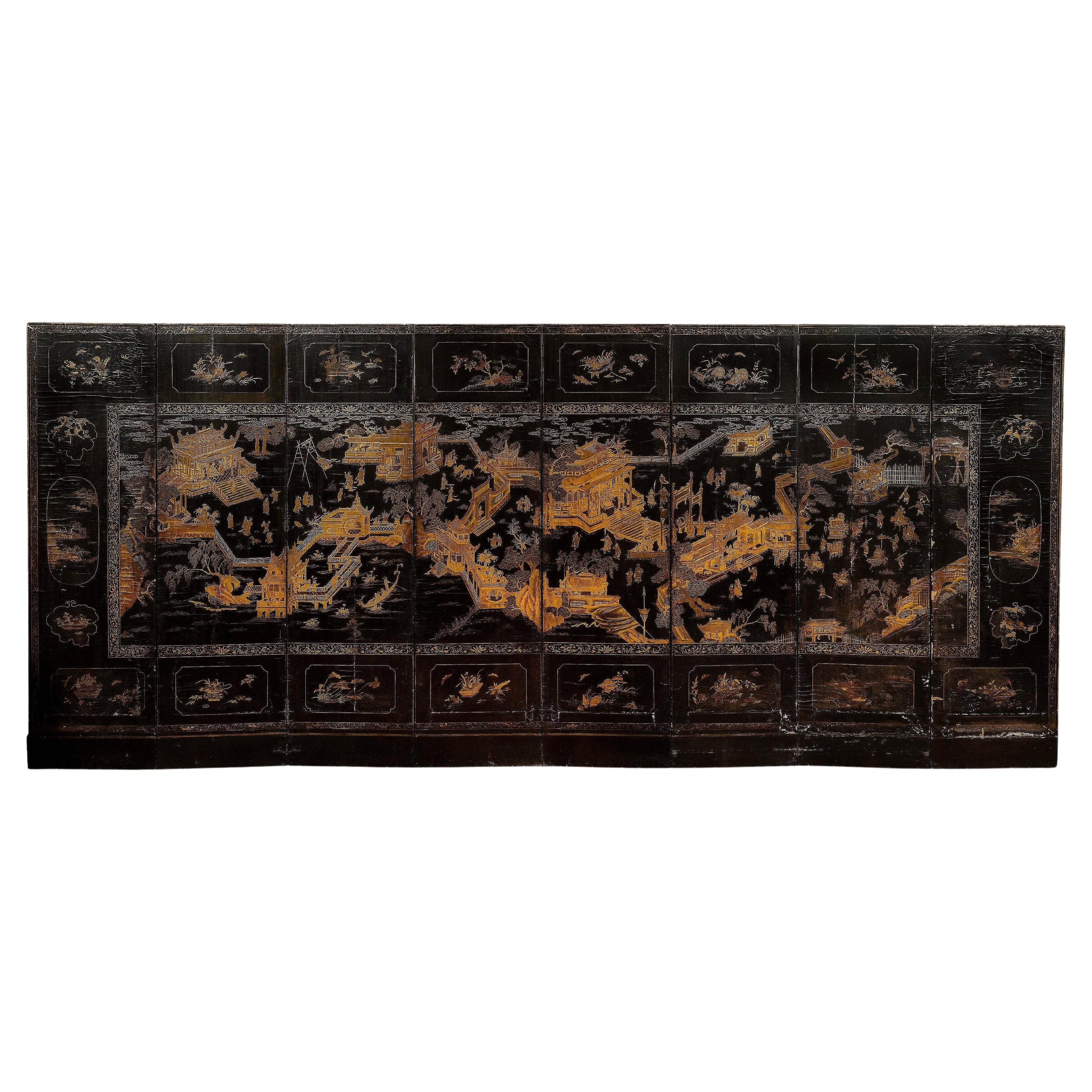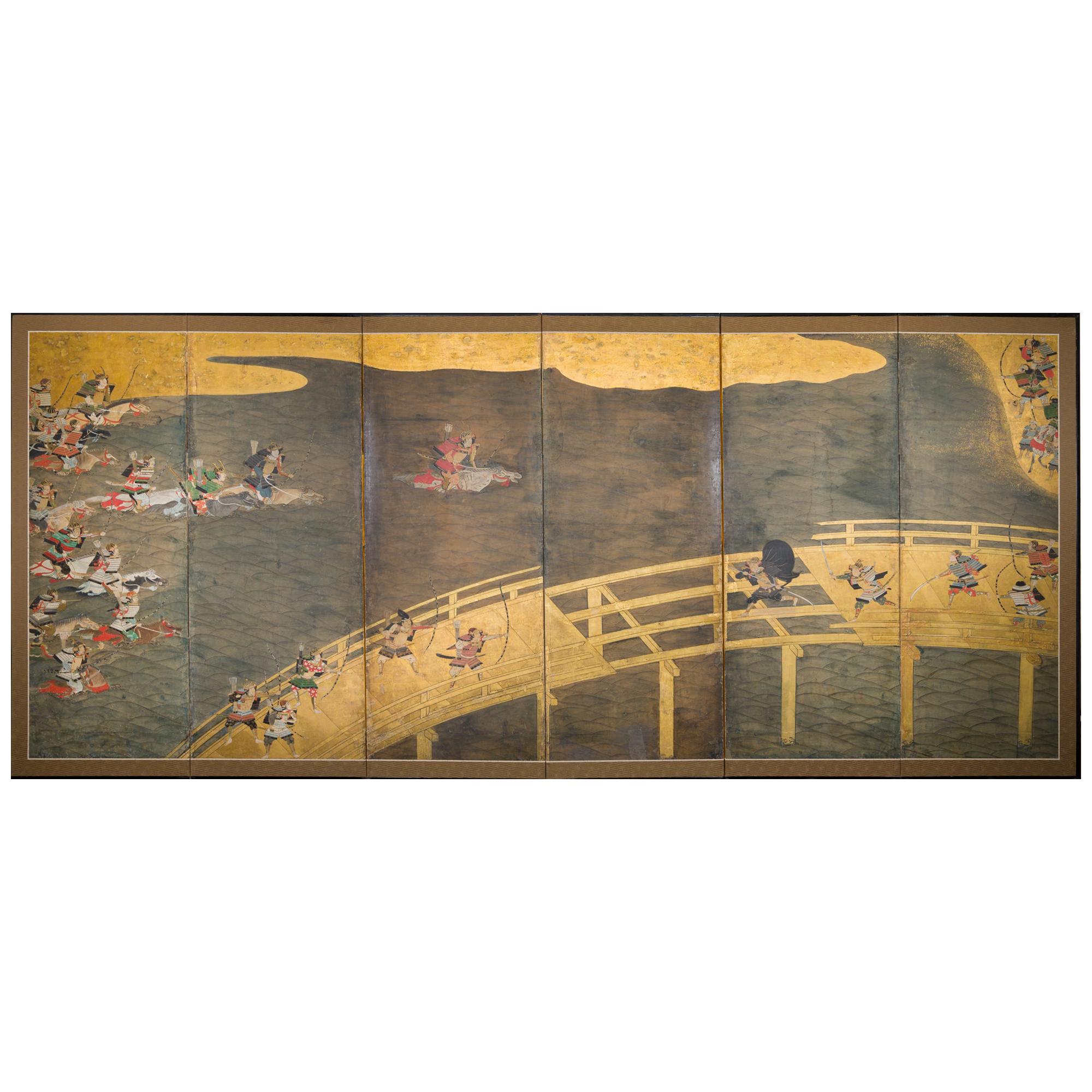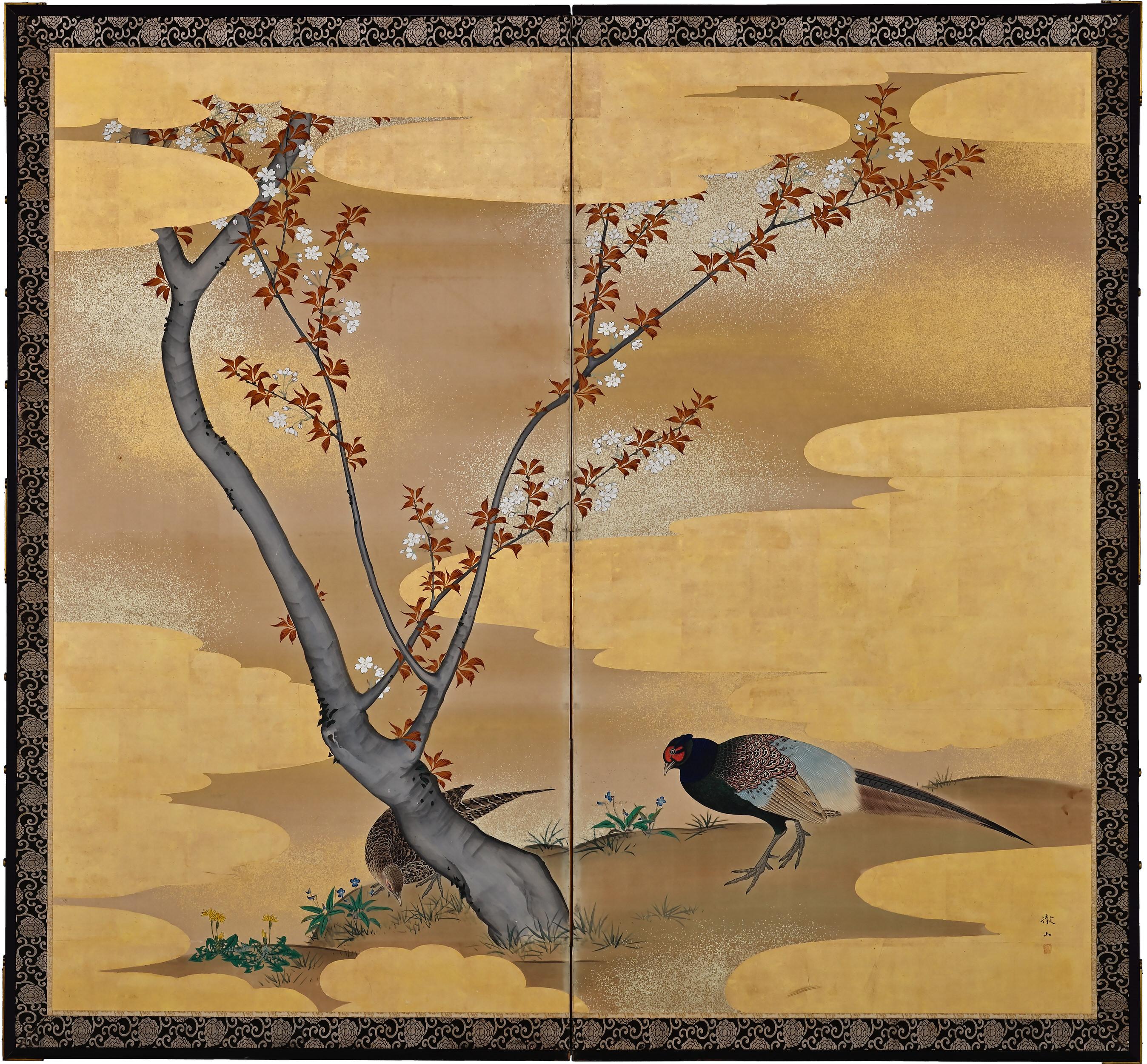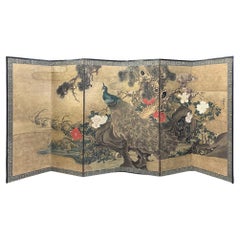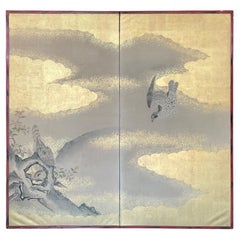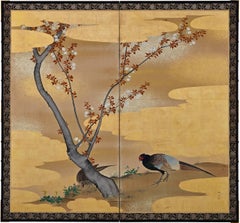Items Similar to Late 18th to Early 19th Century Hawk Screen
Want more images or videos?
Request additional images or videos from the seller
1 of 9
Late 18th to Early 19th Century Hawk Screen
About the Item
Late 18th to Early 19th Century Hawk Screen
Period: Late Edo
Size: 372 x 125 cm (146.4 x 49.2 inches)
SKU: PTA63
Behold the grandeur of the late Edo period encapsulated in this magnificent Hawk screen. A period rich with cultural heritage and artistic depth, the Edo era brought to life scenes that echo Japan's vibrant history and the harmony of nature.
Stretching impressively across your view, this majestic screen transports you to a time where the symbolism of the hawk was revered, representing not just prowess and vigilance but also a celestial connection. Each panel depicts a narrative that unfolds under the watchful eyes of the magnificent hawk, a creature deeply ingrained in Japanese folklore and art.
Crafted meticulously during the transitional phase of the late 18th to early 19th century, this screen embodies the spirit of a Japan standing on the cusp of a new era. The detailed craftsmanship tells tales of expertise handed down through generations, coming alive in the form of this breathtaking piece.
To own this screen is to own a fragment of history, a window into the vibrant and profound narrative of Japanese culture. We invite you to DM us and explore more!
- Dimensions:Height: 49.22 in (125 cm)Width: 146.46 in (372 cm)Depth: 1.19 in (3 cm)
- Style:Edo (Of the Period)
- Materials and Techniques:
- Place of Origin:
- Period:
- Date of Manufacture:unknown
- Condition:Minor losses. Condition report upon request.
- Seller Location:Fukuoka, JP
- Reference Number:1stDibs: LU8121239097172
About the Seller
5.0
Platinum Seller
These expertly vetted sellers are 1stDibs' most experienced sellers and are rated highest by our customers.
Established in 1998
1stDibs seller since 2023
39 sales on 1stDibs
Typical response time: 2 hours
- ShippingRetrieving quote...Ships From: Tambon Hang Dong, Thailand
- Return PolicyA return for this item may be initiated within 7 days of delivery.
Authenticity Guarantee
In the unlikely event there’s an issue with an item’s authenticity, contact us within 1 year for a full refund. DetailsMoney-Back Guarantee
If your item is not as described, is damaged in transit, or does not arrive, contact us within 7 days for a full refund. Details24-Hour Cancellation
You have a 24-hour grace period in which to reconsider your purchase, with no questions asked.Vetted Professional Sellers
Our world-class sellers must adhere to strict standards for service and quality, maintaining the integrity of our listings.Price-Match Guarantee
If you find that a seller listed the same item for a lower price elsewhere, we’ll match it.Trusted Global Delivery
Our best-in-class carrier network provides specialized shipping options worldwide, including custom delivery.More From This Seller
View All18th Century Nagasaki School Tiger Screen
Located in Fukuoka, JP
18th Century Nagasaki School Tiger Screen
Period: Edo
Size: 165 x 172 cm (65 x 67.7 inches)
SKU: PTA69
This exceptional 18th-century screen from the Edo...
Category
Antique Early 18th Century Japanese Edo Paintings and Screens
Materials
Wood, Paper
Lavish 19th Century Maruyama School Peacock Screen
Located in Fukuoka, JP
Lavish 19th Century Maruyama School Peacock Screen
Period: 19th Century
Size: 360 x 173 cm (141.7 x 68.1 inches)
SKU: PF12
Behold the grandeur of the ...
Category
Antique 19th Century Japanese Edo Paintings and Screens
Materials
Wood, Paper
Majestic Hawks Edo Screen by Tosa School
Located in Fukuoka, JP
Majestic Hawks Edo Screen
Period: Edo
Size: 150x168 cm (59x66 inches)
SKU: PTA93
Step back in time to the Edo period with our superb Tosa school screen d...
Category
Antique 19th Century Edo Paintings and Screens
Materials
Gold Leaf
Gold Leafed Screen - Late Edo to Meiji Transition
Located in Fukuoka, JP
Gold Leafed Screen - Late Edo to Meiji Transition
Period: Mid-19th century (Late Edo - Meiji)
Size: 384 x 169 cm
SKU: PN32
Hailing from a pivotal era in Japanese history, this gold...
Category
Antique 19th Century Japanese Edo Paintings and Screens
Materials
Gold Leaf
Late Edo Nio Screen
Located in Fukuoka, JP
Late Edo Nio Screen
Period: Late Edo, 19th century
Size: 170 x 190 cm (67 x 75 inches)
SKU: PTA15
This powerful and extremely rare screen depicts the Nio, Buddhist temple guardians...
Category
Antique 19th Century Japanese Edo Paintings and Screens
Materials
Gold Leaf
Late Edo Silver-leafed Screen
Located in Fukuoka, JP
Late Edo Silver-leafed Screen
Period: Late Edo to Meiji
Size: 186 x 176 cm (73.2 x 69.3 inches)
SKU: PL42
Embracing the essence of the Late Edo to Meiji transition, this oxidized s...
Category
Antique 19th Century Edo Paintings and Screens
Materials
Silver Leaf
You May Also Like
Large 8-wing-screen in Coromandel Lacquer, China, Quing, Late 18th/Early 19th
Located in Walkertshofen, BY
Very large eight-panel sreen with richly decorated landscape vedutas, partly architectural. Very fine execution in coromandel lacquer partially accented with gold. The screen is exec...
Category
Antique Late 18th Century Chinese Qing Lacquer
Materials
Lacquer
Late 17th-Early 18th Century Japanese Six-Panel Screen, Battle at Uji Bridge
Located in Hudson, NY
Japanese six-panel screen: Battle at Uji Bridge, the first battle at Uji was in 1180 and it marked the start of the Heike Wars. The Genji troops crossed the...
Category
Antique Late 17th Century Japanese Edo Paintings and Screens
Materials
Gold Leaf
Early 19th Century Japanese Screen. Cherry Blossom & Pheasants by Mori Tetsuzan
Located in Kyoto, JP
Mori Tetsuzan (1775-1841)
Pheasants and Cherry Blossoms
Two-fold Japanese screen. Ink, color, gofun, gold and silver on paper.
A two-fold Japanese bir...
Category
Antique Early 19th Century Japanese Edo Paintings and Screens
Materials
Gold Leaf
Japanese Screen Painting, Early 19th Century, Autumn Flowers by Sakai Hoitsu
Located in Kyoto, JP
A two-fold Japanese screen by the Rimpa school artist Sakai Hoitsu (1761-1828), Japan, 19th century, Edo period.
This small Japanese folding screen pai...
Category
Antique Early 19th Century Japanese Edo Paintings and Screens
Materials
Wood, Silk
Japanese Six Panel Screen with Hotei, Edo Period, Early 19th Century
Located in Austin, TX
A delightful Japanese six panel painted paper screen featuring the beloved figure Hotei, Edo Period, early 19th century.
Hotei, called Budai in China, and known as the Laughing Buddha or Fat Buddha in the West, is considered to be an emanation of Maitreya, the Buddha of the Future.
In Japan, he also holds a special place as one of the Seven Lucky Gods, being the god of fortune, and protector of children.
He is always portrayed as a mirthful and corpulent man, dressed in loose robes that show off his round belly. He carries a sack with him, said to be filled with treasure. As the protector of children, he is often portrayed with them playing on or around him, as he is here. The children portrayed in this screen are dressed in Chinese style clothing...
Category
Antique Early 19th Century Japanese Edo Paintings and Screens
Materials
Silk, Paper
10 Lacquer Calligraphy Panels, Later Mounted as a Screen, Late 18th Century
Located in Kastrup, DK
Rare screen/room divider.
Set of 10 (8 wide + 2 smaller) panels with original thick red lacquer with calligraphy in gold leaf.
Later frames in black lacquer with profiled leaf-gild...
Category
Antique Late 18th Century Chinese Qing Screens and Room Dividers
Materials
Wood
Recently Viewed
View AllMore Ways To Browse
Antique Explorer
Antique Connection
Standing Screen
Antique Celestial
18th Century Screen
18th Century Transitional
19th Century Japanese Screen
Asia Fragment
Antique Hand Painted Paper Screen
Edo Period Screen
Edo Era
Asian Window Panels
Edo Painting Wood
Japanese Antique Painted Wood Screens
18th Century Hand Screen
Late Edo Period Screens
18th Century Japanese Screens
Wood Window Screen
